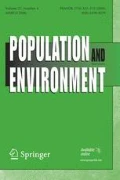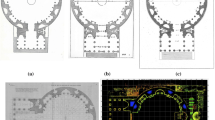Abstract
Preferences for unfamiliar urban environments were studied as a function of urban categories, viewing time, and four predictor variables: complexity, coherence, identifiability, and mystery. A nonmetric factor analysis of the preference ratings for the longest viewing-time condition yielded five dimensions: Contemporary Life, Alley/Factory, Urban Nature, Unusual Architecture, and Older Buildings. The five categories differed significantly in preference, with Urban Nature by far the most preferred and Alley/Factory distinctly disliked. The combination of low coherence and high complexity characterizes the least liked Alley/Factory category, while the role of mystery in the urban setting is highlighted by the most preferred Urban Nature category. The results point to various ways in which the urban environment could be more responsive to people's preferences.
Similar content being viewed by others
References
Alexander, C., Ishikawa, S., & Silverstein, M.A pattern language. New York: Oxford University Press, 1977.
Anderson, E. Visual resource assessment: Local perceptions of familiar natural environments. Doctoral dissertation. University of Michigan. 1978.
Appleyard, D. Notes on urban perception and knowledge. Paper presented at the Environmental Design Research Association (EDRA) Conference, Pittsburgh, 1970.
Bruner, J.S. On perceptual readiness.Psychological Review 1957,64 123–152.
Craik, K.H. Environmental psychology. In P.H. Mussen and R. Rosenzweig (Eds.).Annual review of psychology. Palo Alto, California: Annual Reviews, Inc., 1973, pp. 403–422.
Cullen, G.Townscape. New York: Reinhold, 1961.
Downs, R.M., & Stea, D.Maps in minds: Reflections on cognitive mapping. New York: Harper & Row, 1977.
Downs, R.M., & Stea, D.Image and environment. Chicago: Aldine, 1973.
Herzog, T.R., Kaplan, S., & Kaplan, R. The prediction of preference for familiar urban places.Environment and Behavior 1976,8 627–645.
Kaplan, R. Down by the riverside: Informational factors in waterscape preference. InRiver recreation management and research symposium. USDA Forest Service General Technical Report NC-28, 1977, pp. 285–289.
Kaplan, R. Some methods and strategies in the prediction of preference. In E.H. Zube, R.O. Brush, and J.G. Fabos (Eds.),Landscape assessment: Values, perceptions, and resources. Stroudsburg, Pa.: Dowden, Hutchinson & Ross, 1975, pp. 118–129.
Kaplan, R. A strategy for dimensional analysis. In D.H. Carson (Ed.),Man-environment interactions. Environmental Design Research Association Proceedings, Part 9. 1974, pp. 66–68.
Kaplan, R. The dimension of the visual environment: Methodological considerations. In W.J. Mitchell (Ed.),Environmental design: Research and practice. Proceedings of the Environmental Design Research Association Conference Three, Los Angeles, 1972.
Kaplan, S. Concerning the power of content-identifying methodologies. In T.C. Daniel and E.H. Zube (Eds.).Assessment of amenity resource values. USDA Forest Service Rocky Mountain Station, 1979. (a)
Kaplan, S. Perception and landscape: Conceptions and misconceptions.Proceedings of our national landscape conference. USDA Forest Service General Technical Report TSW-35. 1979, pp. 241–248. (b)
Kaplan, S. An informal model for the prediction of preference. In E. H. Zube, R.O. Brush, and J.G. Fabos (Eds.).Landscape assessment: Values, perceptions, and resources. Stroudsburg, Pa.: Dowden, Hutchinson & Ross, 1975, pp. 92–101.
Kaplan, S., & Kaplan, R. (Eds.).Humanscape: Environments for people. Belmont, Ca: Duxbury (Division of Wadsworth), 1978.
Langer, E.J., & Imber, L.G. When practice makes perfect: Debilitating effects of overlearning.Journal of Personality and Social Psychology 1979,37 2014–2024.
Lingoes, J.C. A general survey of the Guttman-Lingoes nonmetric program series. In R.N. Shepard, A.K. Romney, and S.B. Nerlove (Eds.),Multidimensional scaling, Volume 1. New York: Seminar Press, 1972, pp. 52–68.
Lynch, K.The image of the city. Cambridge, Mass.: MIT Press, 1960.
Milgram, S. The experience of living in cities.Science 1970,167 1461–1468.
Parr, A.E. City and psyche.Yale Review 1965,55 71–85.
Smith, C.J. The geography of mental health. Association of American Geographers Resource Paper No. 76-4, 1976.
Author information
Authors and Affiliations
Additional information
This research was supported in part by a grant from the Grand Valley State Colleges Research Development Fund to Thomas Herzog and in part by the Urban Forestry Unit of the U.S. Forest Service's North Central Experimental Station in a cooperative research agreement with R. Kaplan and S. Kaplan.
Rights and permissions
About this article
Cite this article
Herzog, T.R., Kaplan, S. & Kaplan, R. The prediction of preference for unfamiliar urban places. Popul Environ 5, 43–59 (1982). https://doi.org/10.1007/BF01359051
Issue Date:
DOI: https://doi.org/10.1007/BF01359051




